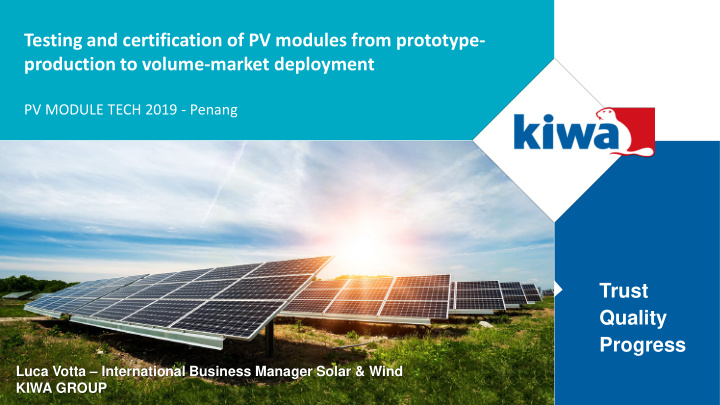



Testing and certification of PV modules from prototype- production to volume-market deployment PV MODULE TECH 2019 - Penang Trust Quality Progress Luca Votta – International Business Manager Solar & Wind KIWA GROUP
What Testing we do Services Inspection to create People Processes trust Certification OUR OFFER in your Products Training Organization Management Systems Consultancy
Key figures founded 1948 globally supported by NPM Capital , part of SHV in the Netherlands active Holdings offices in >40 a partner and agent network an operating income ~4,700 countries of € 523m in 2018 employees
100 Offices in over 40 Countries
Our mascot: the beaver Hard- working links with our values and markets Efficiency Water Steady and friendly Technical skills Healthy Progress environment Construction and infrastructure Cooperation
Dedicated Services for the Thermal Collectors Solar Market PV Modules Grid Codes Components and Structures Kiwa is one of the leading Certification Bodies for Testing and Certification of Secondary Solar Products Market
Certification of Photovoltaic Modules International Quality Standard This is what we normally take into consideration when we talk about quality of Solar PV Modules Country Local Certifications Special Requirements But we have to consider that every successful market deployment of Solar Safety Requirements PV Modules starts from initial design, concepts and prototypes! R&D
A case of study… The cooling effect Reduce temperature is one of the key topics to increase production - How Kiwa can helps with R&D activities before to step into certification process? - Which kind of results / benefits are achievable? - Which is the plus value for the PV solar manufacturers? - What we discovered in our labs during the R&D activities? A case of study… …..improving the output and Lifetime of PV modules through cost effective cooling The case
Heat Losses Effect The effect of higher temperatures at the moderate working range is a drop of 6-7% in efficiency, or the equivalent of approximately 20 TEMPERATURE vs EFFICIENCY FOR A Si SOLAR CELL Watt peak per 60-cell module Effect of high temperatures on degradation/ lifetime not included in standard IEC tests output measure in flashtest at Tcell of 25 o C, irradiation 1.000 Watts/m2, STC: AMN 1,5 measuring Tcell at 800 Watts/m2, Tambient 25 o C, wind 1 m/s, mostly NOCT: around 40-50 o C
Heat Losses Effect Cell temperatures are however not 35 o maximized to 60 o C, not even in moderate environments where they can measure 70 o C 25 o or more, while they easily reach 80-90 o C in T-ambient in o C desert & tropic regions. This is dT of 60-70 o C 15 o above STC, losing 20% output . How to cool? 80 o 60 o 40 o T-cell in o C 20 o DATA FROM A SINGLE DAY (Sevilla, Spain- May 2019)
Test Method -Example of Installations on biaxial tracker. Thermal effect study -Test Method by comparison. Mainly Outdoor -Several conditions taken into consideration (irradiation, wind, temperature, duration). -Test locations: Italy and Spain. -PV module comparisons: several technologies: mono-, poly, H- pattern and back-contact technology
Lower Temperature Strong effect on temperature. Performance of different technologies for a typical day in horizontal position. Performances of the cooling samples are better for the entire measured period. (Figure 1.) Effect of lower temperatures at tracking implemented in design. Meteorological data, for the same day, in both vertical and horizontal position, where the grey line is a normal panel and the orange is the cooling one. (Figure 2.) Source: Kiwa lab springtime, Northern Italy
High Performances Blue points are the gain values of the power between a standard module and a cooling module. Orange line represent the daily average of the gain. (Figure 1.) Trend of the gains over an exposure period of 10 days in normal conditions and landscape orientations. (Figure 2.) Power measurements are normalized according to the STC performance test in order to compare results. Source: Kiwa lab springtime, Northern Italy
High Performances Long term exposure. The kWh output effect, already in fixed tilt, is significant – also at moderate temperatures. The lower temperature (in everyday/thermal cycle) reduces degradation, prolonging lifespan. Peak : 13.00-14.00 Sun : 985 W/m2 : 29,40 o C T.amb : 68,90 o C Tref Spain Outdoor installation – Springtime Long Term measurement
Lower heat losses Wind, ambient temperature and, mainly, irradiation have effects on output performance of PV modules. Predicting cooling gains per location (simulation) is possible by measuring the temperature of the reference (= standard) module using the comparison method. The cooling system tested shows an additional 1,4% extra output per 10°C above 35°C. Valid up to 4,5 m/s windspeed. Trend T° vs Kwh
Conclusions -Results of the study presented in June 2019 in a webinar with more than 600 participants globally. -After 2 years of R&D activities and Certification processes, prototypes are ready for market deployment today. -High benefits for manufacturers in having R&D lab activities combined with Testing and Certification activities (One Stop Shop Service) -Possibility to add services like IPP program, in-line inspection and third party audits for manufacturers of PV modules. -
Thank you! Luca Votta International Business Manager Solar & Wind KIWA Group luca.votta@kiwacermet.it www.kiwa.com
Recommend
More recommend